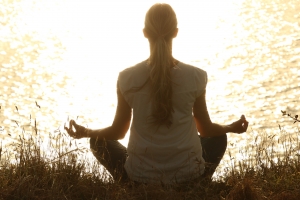The basics of mindfulness meditation
January 31, 2017
 Stress is something we all experience, and it takes a toll on our health. A recent survey from the American Psychological Association says that more than half of Americans experience extreme levels of stress, which could lead to a higher risk of heart attack and stroke. Experts say individuals need to find a way to reach a state of calm, which is why an increasing number of people are turning to mindfulness meditation. Mindfulness simply means to be fully present and aware of where we are and what we are doing, while not overly reacting or becoming overwhelmed by the world around us. When practicing mindfulness meditation, an individual typically sits with their eyes closed, either cross-legged on a cushion or up straight in a chair, and focuses on their breathing or sensations in their body. While experts say the focus should not be on the benefits, but the practice, reasons to practice mindfulness include lower stress, better ability to focus, and reduced mental chatter. Research continues to show the relationship between the body and the brain, and new studies find that consistent mindfulness practices could help ease stress and anxiety. One study, published in the journal, Psychiatry Research, looked at 89 people with generalized anxiety disorder (GAD). The team randomly assigned the participants to either an eight-week Mindfulness-Based Stress Reduction (MBSR) or Stress Management Education course. Developed at the University of Massachusetts Medical School by Jon Kabat-Zinn, MBSR incorporates weekly meetings with instructions for home practice. Participants in the MBSR course are taught techniques and exercises, such as breath awareness, yoga, and body scan meditations. Click here to read a related article on the subject. Previous studies were thought to be riddled with potential placebos, so extra care was taken to craft an experiment closer to a randomized clinical trial. The point of this study was to test in-the-moment stress before and after the program. To do this, researchers called upon an old lab standard, the Trier Social Stress Test. Before the courses started and right after they concluded, the researchers put the participants through eight minutes of public speaking, followed by a round of videotaped mental math in front of a panel of researchers. The participants' blood was drawn to take measurements of stress hormones, in this case cortisol and adrenocorticotropic hormone (ACTH), and inflammatory proteins, IL-6 and TNF-α. At the end of the eight-week period in which participants took their respective courses, those in the MBSR group reacted to stress better and had a lower hormonal and inflammatory response, with significantly reduced levels of ACTH, IL-6, and TNF-α, than those in the education course, or control group. In fact, the control participants were actually more stressed the second time they did the test, possibly because they knew and anticipated what they would feel and experience. This isn't the first study to elude to the benefits of mindfulness meditation. A 2014 meta-analysis in the Journal of the American Medical Association found that meditation was linked to significantly reduced anxiety, depression, and insomnia. A 2009 study from Harvard University, also using MBSR, found that people had a significant reduction in volume in the amygdala, the part of the brain that governs stress. We all experience stress at some point in our lives. Routine mindfulness practices equip individuals with the skills to handle difficult situations. Some even say the practice is modifying the physical structure of your brain when you train it to be mindful, according to Mindful.org. Anyone can start mindfulness practices, regardless of age, physical limitations, or religion—while the term can seem exotic or obscure, mindfulness meditation is as simple as being present and aware of what you are experiencing via your senses, or thoughts and emotions. Here's how you can get started:
Stress is something we all experience, and it takes a toll on our health. A recent survey from the American Psychological Association says that more than half of Americans experience extreme levels of stress, which could lead to a higher risk of heart attack and stroke. Experts say individuals need to find a way to reach a state of calm, which is why an increasing number of people are turning to mindfulness meditation. Mindfulness simply means to be fully present and aware of where we are and what we are doing, while not overly reacting or becoming overwhelmed by the world around us. When practicing mindfulness meditation, an individual typically sits with their eyes closed, either cross-legged on a cushion or up straight in a chair, and focuses on their breathing or sensations in their body. While experts say the focus should not be on the benefits, but the practice, reasons to practice mindfulness include lower stress, better ability to focus, and reduced mental chatter. Research continues to show the relationship between the body and the brain, and new studies find that consistent mindfulness practices could help ease stress and anxiety. One study, published in the journal, Psychiatry Research, looked at 89 people with generalized anxiety disorder (GAD). The team randomly assigned the participants to either an eight-week Mindfulness-Based Stress Reduction (MBSR) or Stress Management Education course. Developed at the University of Massachusetts Medical School by Jon Kabat-Zinn, MBSR incorporates weekly meetings with instructions for home practice. Participants in the MBSR course are taught techniques and exercises, such as breath awareness, yoga, and body scan meditations. Click here to read a related article on the subject. Previous studies were thought to be riddled with potential placebos, so extra care was taken to craft an experiment closer to a randomized clinical trial. The point of this study was to test in-the-moment stress before and after the program. To do this, researchers called upon an old lab standard, the Trier Social Stress Test. Before the courses started and right after they concluded, the researchers put the participants through eight minutes of public speaking, followed by a round of videotaped mental math in front of a panel of researchers. The participants' blood was drawn to take measurements of stress hormones, in this case cortisol and adrenocorticotropic hormone (ACTH), and inflammatory proteins, IL-6 and TNF-α. At the end of the eight-week period in which participants took their respective courses, those in the MBSR group reacted to stress better and had a lower hormonal and inflammatory response, with significantly reduced levels of ACTH, IL-6, and TNF-α, than those in the education course, or control group. In fact, the control participants were actually more stressed the second time they did the test, possibly because they knew and anticipated what they would feel and experience. This isn't the first study to elude to the benefits of mindfulness meditation. A 2014 meta-analysis in the Journal of the American Medical Association found that meditation was linked to significantly reduced anxiety, depression, and insomnia. A 2009 study from Harvard University, also using MBSR, found that people had a significant reduction in volume in the amygdala, the part of the brain that governs stress. We all experience stress at some point in our lives. Routine mindfulness practices equip individuals with the skills to handle difficult situations. Some even say the practice is modifying the physical structure of your brain when you train it to be mindful, according to Mindful.org. Anyone can start mindfulness practices, regardless of age, physical limitations, or religion—while the term can seem exotic or obscure, mindfulness meditation is as simple as being present and aware of what you are experiencing via your senses, or thoughts and emotions. Here's how you can get started: - Find a quiet spot in your home our outside. You can leave the lights on or sit in natural light. Ideally, there will be minimal distractions and clutter.
- Set a specific amount of time to "practice" for. Start slowly, for five to 10 minutes each day, and build up to longer sessions. Some people do a session in the morning and in the evening. Select a time of day and duration that works best for you—the point is to avoid obsessing over the particulars. Use a timer so the focus is solely on your practice.
- Take a seat. Choose whatever feels comfortable and natural for you. some prefer a yoga mat or cushion, while others prefer a chair or bench. Whatever you choose, make sure it's stable and solid.
- Cross your legs, if you're sitting on the floor. If you are sitting on a chair, sit up straight with your feet touching the floor.
- Straighten your upper body. You shouldn't feel stiff. Relax your spine, head, and shoulders and allow them sit naturally.
- Let your hands drop onto the tops of your legs, and keep your upper arms parallel with your upper body.
- Drop your chin and let your gaze fall gently downward. You may let your eyelids lower, or close them altogether, but it is not necessary.
- Relax and breathe. Focus on your breath or the sensations in your body. Don't worry if your mind starts to wander. Return your focus back to the breath.




















SHARE